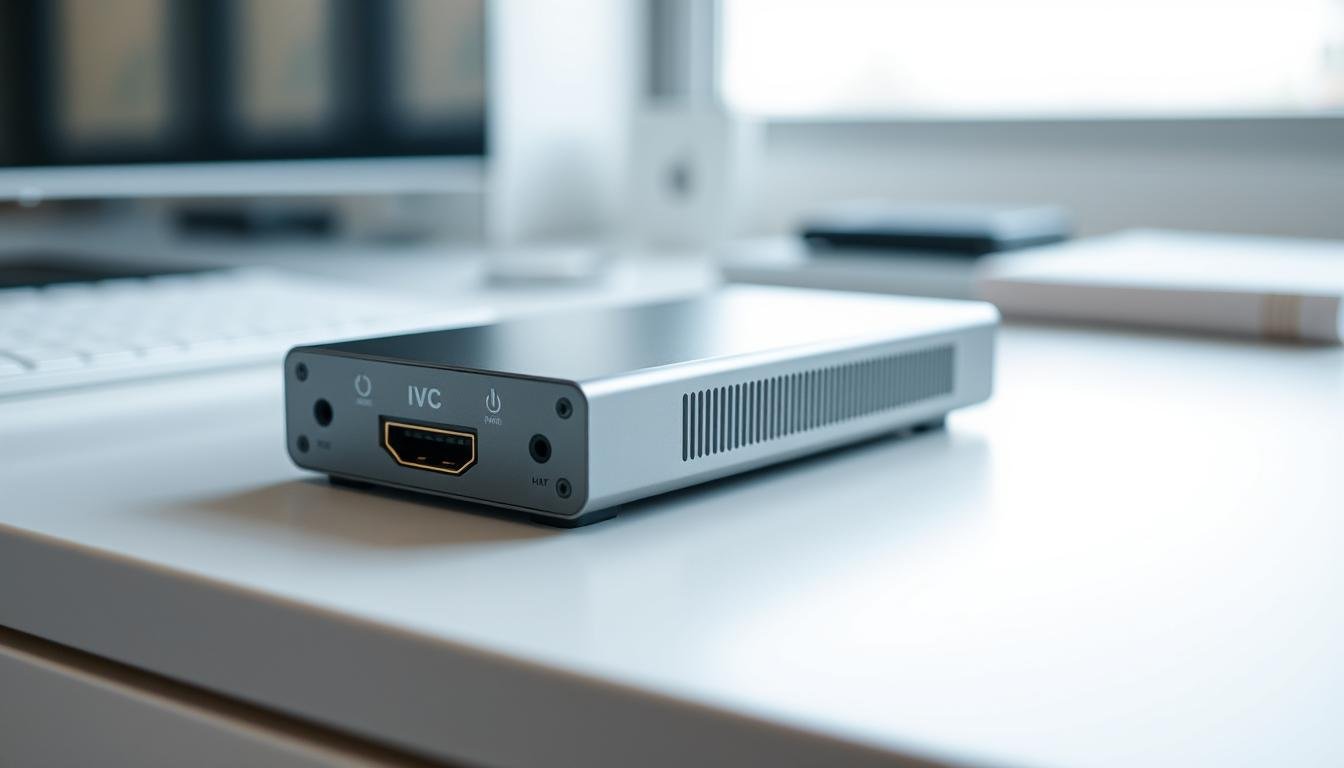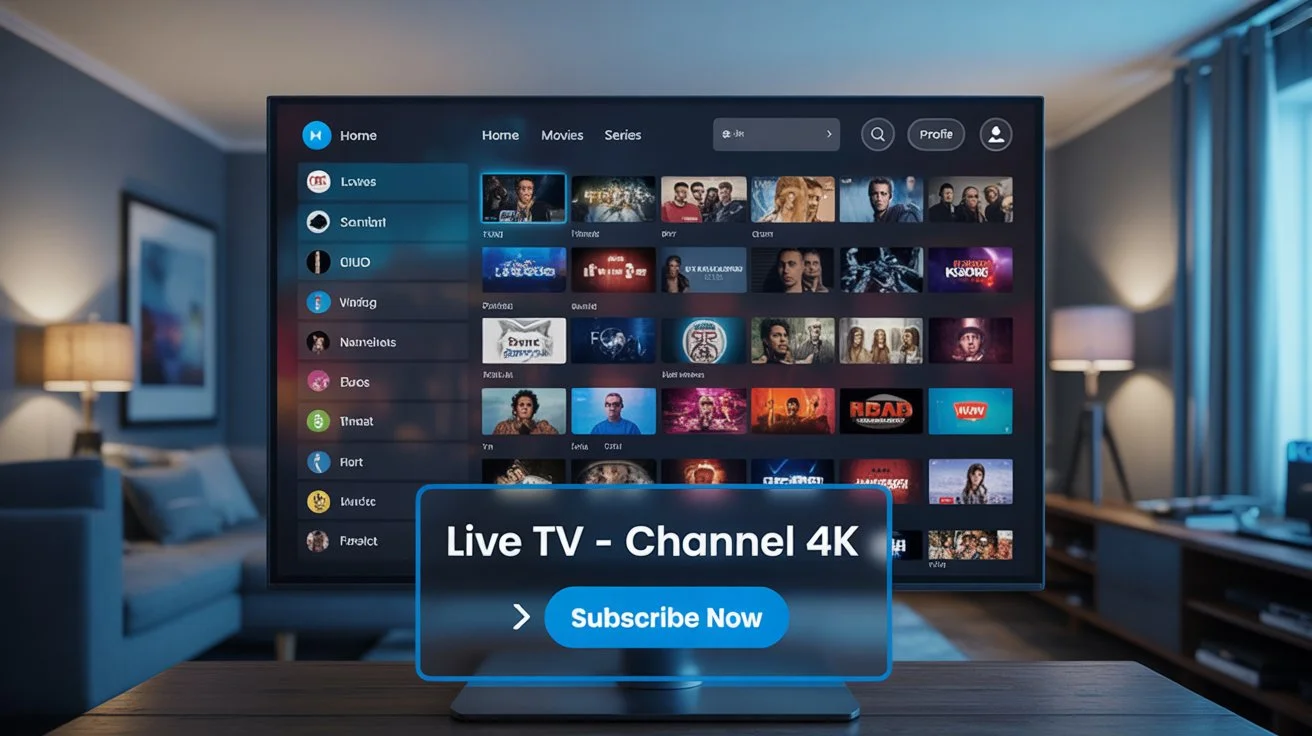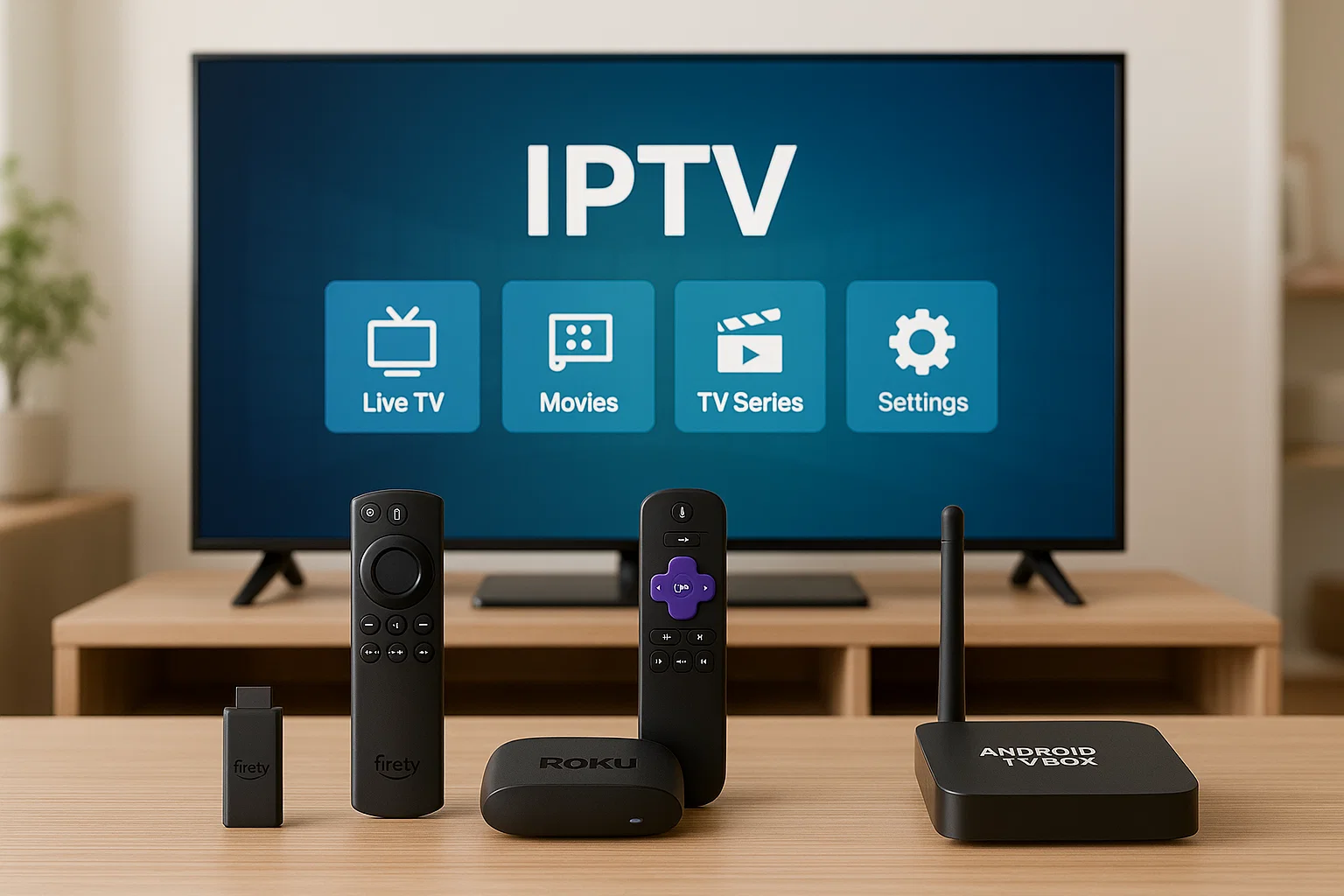Are you tired of buffering and poor video quality during live streams? New devices like the ZowieBox have come out. They support HDMI HEVC encoding for smooth 4K Ultra HD video streaming.
The HDMI HEVC encoder is key for better video quality and streaming efficiency. It uses the High Definition Multimedia Interface and advanced digital video encoding. This means your video content is delivered at the highest quality.
Key Takeaways
- HDMI HEVC encoders enable high-quality video streaming.
- Devices like ZowieBox support 4K Ultra HD video streaming.
- Advanced digital video encoding ensures superior video quality.
- High Definition Multimedia Interface is crucial for efficient video streaming.
- HDMI HEVC encoders improve streaming efficiency.
What You Need to Know About HDMI HEVC Technology
Exploring high-quality video streaming means learning about HDMI HEVC technology. It combines HDMI with HEVC, changing how we send and compress video.
Defining HDMI and HEVC Standards
HDMI sends high-definition video and audio. HEVC, or H.265, is a new way to compress video. It’s better than H.264.
HDMI Capabilities and Versions
HDMI has grown with new versions. Each one brings more features, like more bandwidth and support for higher resolutions. HDMI 2.1 can handle 8K at 60 Hz.
- Supports higher resolutions and refresh rates
- Enhanced Audio Return Channel (eARC)
- Increased bandwidth for future applications
HEVC (H.265) Compression Benefits
HEVC brings big compression wins. It lets you stream high-quality video using less bandwidth. Studies show HEVC can cut bitrate by up to 50% while keeping video quality the same.
The Convergence of High Definition Multimedia Interface and Advanced Compression
Putting HDMI and HEVC together makes sending high-quality video easy. This mix is key for fast, high-bandwidth video, like live streams and games.
How HDMI HEVC Encoders Transform Video Streaming
HDMI HEVC encoders have changed video streaming a lot. They make video look better and use less bandwidth.
The Evolution from H.264 to HEVC
Switching from H.264 to HEVC is a big step up. HEVC makes videos look better at lower bitrates. This is key for streaming where bandwidth is tight.
Bandwidth Efficiency Improvements
HDMI HEVC encoders cut down on bandwidth needs. They can reduce bitrate by up to 50% compared to H.264. This makes streaming high-res content more efficient.
Visual Quality Enhancements
HEVC also makes videos look better. Its advanced tech keeps more details, giving a superior viewing experience. An expert says, “HEVC is a game-changer for streaming, offering unparalleled quality at lower bitrates.”
“The adoption of HEVC will significantly improve the efficiency of video streaming, enabling higher quality content delivery over limited bandwidth networks.”
Using HDMI HEVC encoders makes your streaming setup ready for the future. It can deliver high-quality content efficiently.
Key Benefits of HDMI HEVC Encoders for Your Streaming Setup
HDMI HEVC encoders change how we stream video. They make streaming better and more efficient. Knowing their benefits can make your streaming setup better.
Superior Compression Efficiency
HDMI HEVC encoders are great at compressing video. They use the HEVC (H.265) standard to make video files smaller. This is good for streaming high-definition content without using too much bandwidth.
Devices like the ZowieBox support H.264 and H.265/HEVC. This means they can handle different compression levels well.
Enhanced Video Quality at Lower Bitrates
Enhanced video quality is a big plus of HDMI HEVC encoders. They keep video looking good even when bandwidth is low. This is great for streaming services because it means everyone can watch high-quality video.
Reduced Storage Requirements
HDMI HEVC encoders also mean you need less storage. They make video files smaller. This is good for platforms with lots of videos because it saves space.
Cost Savings for Content Delivery
Using HDMI HEVC encoders can also save money. Smaller files need less bandwidth to stream. This can lower costs for streaming services that move a lot of data.
In short, HDMI HEVC encoders bring many benefits. They improve compression, video quality, and save space and money. As streaming demand grows, using these encoders is a smart choice for content providers and broadcasters.
4K Video Encoding: Unleashing Ultra High Definition Content
Exploring high-definition video streaming means knowing about 4K video encoding. It’s key for ultra-high quality content. With 4K’s rise, we need efficient encoding solutions for ultra-high definition video.
Meeting the Demands of 4K Resolution
4K resolution, or Ultra High Definition (UHD), needs a lot of bandwidth and processing power. HDMI HEVC encoders are made to meet these needs, offering a strong solution for 4K encoding.
For 4K resolution, focus on these important points:
- High processing power for complex encoding algorithms
- Enough bandwidth for smooth 4K streaming
- Advanced encoding like HEVC to lower bitrate needs
HDR Support and Color Depth Considerations
High Dynamic Range (HDR) support and color depth are key for a top-notch viewing experience. HDMI HEVC encoders that support HDR and higher color depths (like 10-bit or 12-bit) boost your 4K content’s visual quality.
Bitrate Requirements for 4K Streaming
The bitrate needed for 4K streaming varies based on encoding tech, resolution, and frame rate. HEVC encoding cuts down bitrate needs compared to older codecs like H.264.
Optimal Settings for Different Viewing Scenarios
For different viewing scenarios, adjust your 4K streaming settings this way:
- For fast-paced content like sports or gaming, use a higher bitrate and frame rate.
- For static content like movies, a lower bitrate is okay while keeping quality.
Balancing Quality and Bandwidth Consumption
It’s important to balance quality and bandwidth for efficient 4K streaming. Adjusting encoding settings and using advanced technologies helps achieve high-quality streaming while saving bandwidth.
Devices like the ZowieBox can capture and stream 4K video. They’re great for gaming and high-definition video content. Knowing your encoding hardware’s capabilities and limits helps optimize your 4K streaming setup for top performance.
Low Latency Encoding: Essential for Interactive Applications
Low latency encoding is key for apps that need real-time action. It’s important to cut down delay in video encoding for a smooth user experience.
Understanding Latency in Video Encoding
Latency in video encoding is the time gap between capturing and showing video. HDMI HEVC encoders help reduce this gap. Things like encoding methods, buffer sizes, and how fast the computer is also play a part.
Techniques to Minimize Encoding Delay
To cut down encoding delay, you can try a few things. Adjusting encoder settings and using low latency encoding modes help. Also, using encoders made for low latency, like those in AV over IP solutions, is a good idea.
Use Cases Requiring Ultra-Low Latency
Some apps need ultra-low latency to work well. These include:
-
Gaming and E-Sports Broadcasting
Gaming and e-sports need video to be sent in real-time. Low latency encoding makes sure the video gets to viewers quickly, improving their experience.
-
Live Event Streaming
Live event streaming also benefits from low latency. It lets viewers interact with the event in real-time, making it more fun.
-
Remote Operation Systems
Remote operation systems need low latency for commands to work fast. This is very important for apps where quick action is needed.
Solutions like ZowieBox are made for low latency. They’re great for apps like gaming and live broadcasting. By using low latency encoding, you can make your interactive apps work better.
HDMI HEVC Encoder Implementation for Live Streaming
To improve your live streaming, think about using an HDMI HEVC encoder. It offers top-notch video streaming with smart compression. This makes it perfect for live events, gaming, and more.
Hardware Requirements for Professional Streaming
For top-notch streaming, you need a strong HDMI HEVC encoder. It should handle high-resolution video well. The ZowieBox can stream to YouTube and Twitch directly, making it easy to use.
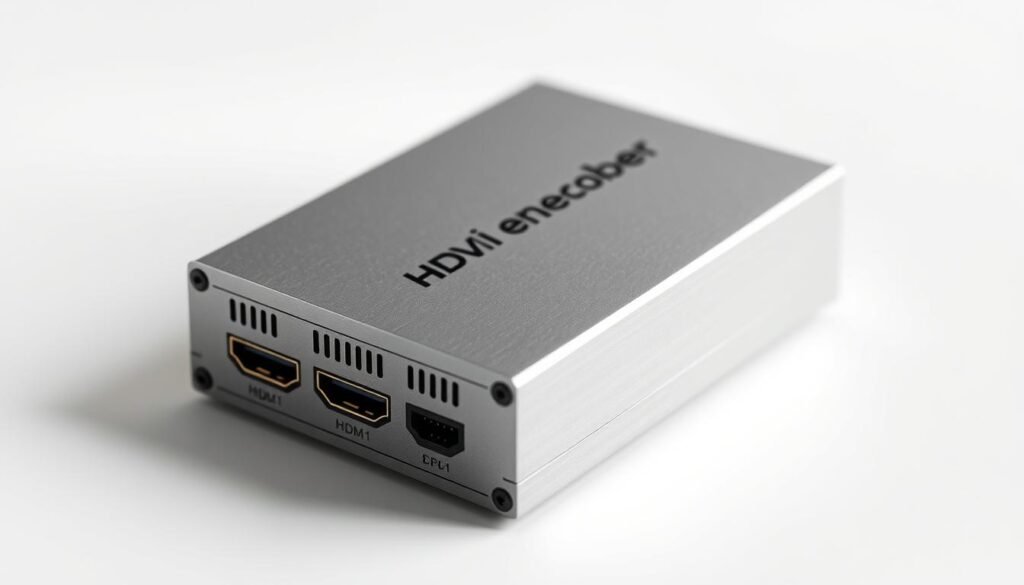
Software Configuration and Optimization
After getting the right hardware, setting up the software is next. Most live streaming encoders have easy-to-use interfaces. You can tweak settings like bitrate, resolution, and frame rate for the best stream quality.
Integration with Streaming Platforms
Connecting your encoder for streaming to popular platforms is easy. Here’s how to do it:
YouTube Live Setup
To stream on YouTube Live, set up your encoder with YouTube’s suggested settings. This includes resolution, bitrate, and frame rate.
Twitch Configuration
Twitch has its own quality standards for streams. Make sure your encoder meets these for a great viewing experience.
Enterprise Streaming Solutions
Big organizations might need more complex setups. This includes handling multiple sources and advanced security.
By following these tips, you can use an HDMI HEVC encoder well. This ensures your live streams are high-quality and reliable.
AV over IP Solutions Using HDMI HEVC Technology
HDMI HEVC encoders are changing how we share high-quality video. They make streaming and broadcasting easier. This combo is great for today’s digital video needs.
Network Infrastructure Requirements
You need a strong network for AV over IP to work well. This means high-bandwidth switches and routers for HD video. A good network gives you low latency and high reliability for live video.
Scalability Advantages for Multi-Point Distribution
AV over IP solutions grow with your needs. HDMI HEVC encoders let you send video to many places easily. This is perfect for live event broadcasting and multi-room video distribution.
Security Considerations for IP-Based Video
Security is key with AV over IP. You must protect your network from hackers. Use encryption and secure authentication protocols to keep your video safe.
Cost Comparison with Traditional AV Distribution
AV over IP with HDMI HEVC saves money. It uses your IP network, cutting down on AV costs. This means lower capital expenditures and operational costs.
Selecting the Right HDMI HEVC Encoder for Your Needs
Choosing the right HDMI HEVC encoder means looking at a few key things. You want to make sure it’s good for streaming high-quality video.
The market has many HDMI HEVC encoders. You can find everything from top-notch ZowieBox to more affordable options. They fit different needs and budgets.
Professional Broadcast Equipment Considerations
For pro broadcasting, you need an HDMI HEVC encoder that’s up to the task. This includes live events and 4K streaming. Look for encoders with low latency, high bitrate, and strong hardware.
These encoders are built for reliability and top performance. They’re perfect for important broadcasting jobs.
Prosumer Options for Content Creators
Prosumer encoders for streaming strike a balance between quality and cost. They’re great for creators who want top video without spending too much.
These encoders support 4K and HDR. They’re good for many content creation tasks.
Budget-Friendly Solutions for Beginners
For newbies, budget-friendly HDMI HEVC encoders are a good start. They might not have all the bells and whistles. But they still work well for simple streaming.
- Resolution and frame rate support
- Bitrate control and flexibility
- Latency and its impact on your application
- Compatibility with your existing equipment
Price-Performance Analysis
When picking an HDMI HEVC encoder, think about price and what you get. Look at the features you need and compare models. This helps find the best deal for your money.
Looking at how different broadcast equipment stacks up in terms of cost and value is smart. It helps you choose without spending too much.
Setting Up Your HDMI HEVC Encoder for Optimal Performance
Setting up your HDMI HEVC encoder right is key for top-notch video streaming. Follow these tips for the best setup and performance.
Physical Connections and Signal Flow
First, check that all connections are tight and right. Plug your video source into the HDMI input on your HDMI HEVC encoder. Make sure the cable is HDMI 2.0 for 4K at 60 Hz. If you have an external audio, plug it in too.
Set up your signal flow to fit your needs. For live events, adjust your encoder for video and audio.
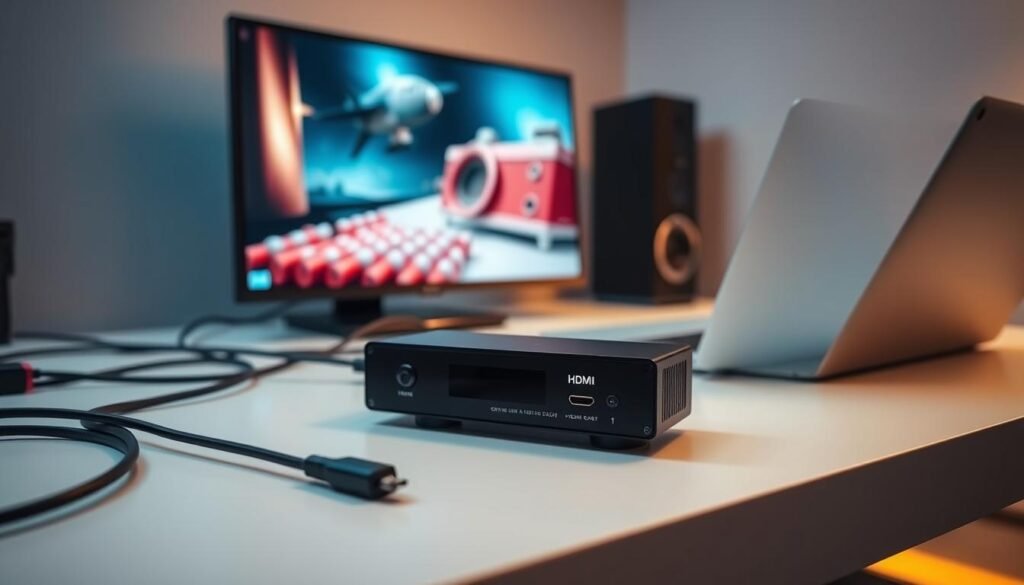
Encoding Parameter Configuration
Setting encoding parameters is key for good video and less bandwidth use. Your live streaming encoder lets you tweak settings like resolution, frame rate, and bitrate. For 4K, you’ll need a higher bitrate for quality.
ZowieBox encoders make setting up easy. They let you tweak and check settings easily.
Monitoring and Quality Control
Keep an eye on your stream’s quality always. Use the encoder’s tools to spot problems like dropped frames or sync issues. Regular checks help fix problems fast.
Troubleshooting Common Issues
Even with careful setup, problems can pop up. Issues like wrong settings, network problems, or hardware issues can happen. Check your encoder’s manual for help. For example, latency might need setting changes or network checks.
By following these steps and using your video compression technology well, you’ll get the best from your HDMI HEVC encoder.
Future Trends in Digital Video Encoding Technology
The future of digital video encoding looks bright. New technologies will change how we encode and share videos.
Several key trends are emerging:
- AI-enhanced encoding algorithms for more efficient compression
- Support for higher resolutions, such as 8K, and beyond
- Cloud-based and distributed encoding solutions for greater scalability
- Integration with virtual and augmented reality technologies
AI-Enhanced Encoding Algorithms
AI-driven encoding will change the game. It will make videos smaller and still look great.
8K and Beyond: Preparing for Higher Resolutions
With 8K resolution on the rise, we need better encoding. It must handle the extra details of higher quality videos.
Cloud-Based and Distributed Encoding Solutions
Cloud-based encoding brings scalability and flexibility. It makes processing videos more efficient.
Integration with Virtual and Augmented Reality
Combining digital video encoding with VR and AR will create deeper experiences. It will make watching videos even more engaging.
Conclusion
HDMI HEVC encoders are changing the game for video streaming. They use the High Definition Multimedia Interface and HEVC compression. This means you get better video quality and use less bandwidth.
If you make videos, broadcast, or just love streaming, an HDMI HEVC encoder is a game-changer. It makes your videos look great, uses less data, and saves space. These encoders are set to boost your streaming to new heights.
Knowing about HDMI HEVC technology helps you improve your streaming setup. It keeps you up-to-date in the fast-changing world of digital video.
